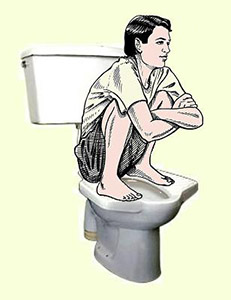Other Methods of Hemorrhoid Prevention and Relief
There are a number of other methods that you can use to reduce your risk of developing hemorrhoids (also haemorrhoids or piles), or achieve a certain amount of relief if you already have them. These include:
- Reduce the level of strain and duration of bowel movements. Only empty your bowels when you feel that the urge to do so is reasonably strong; certainly don’t try to force yourself to do so when you don’t need to. However, don’t try to ‘hold on’ and resist the urge to empty your bowels for too long. Also don’t sit on the toilet for longer than you really need to.
- Don’t rub your anal region too hard when cleaning yourself after a bowel movement, especially with dry toilet paper, as this can increase irritation and bleeding from prolapsed or external hemorrhoids. Using moist wipes or even washing yourself with water are better than using normal dry toilet paper.
- Washing the anus with cool water and soap can reduce swelling and increase blood supply for quicker healing, and helps to remove any irritating fluids that may have come from the intestines.
- Using hemorrhoid cushions, especially when sitting for prolonged periods, can help to relieve pressure and hence reduce pain and discomfort in the anal area caused by sitting.
- Wearing only lightweight underwear, or no underwear at all, can improve comfort.
- Practice better posture when both sitting and standing, to minimize unnecessary strain and pressure in the anal region.
- Take steps to minimize stress in your life. This will significantly reduce your risk of developing high blood pressure. If sources of stress are unavoidable, then find some time on your daily routine for relaxation. Specific relaxation techniques such as meditation can be very effective in making the most of such times to combat your stress levels.
Use of squat toilets

Squat Toilet
(Actually a hybrid toilet design that can
be used either sitting or squatting.)
Modified public domain image from Wikipedia.
Emptying the bowels in a squatting position, as opposed to the unnatural sitting position imposed by normal toilets, can be beneficial. The incidence of hemorrhoids is very low in the developing world, where people normally squat for bodily functions. Hemorrhoids have only become common in the developed world since the use of the sit-down toilet became widespread. A number of other bowel diseases and conditions, including bowel cancer, show a similar correlation.
In one study, by Dr Berko Sikirov, 18 out of 20 hemorrhoid suffers were completely relieved of their symptoms after converting to squat toilets, with no recurrence after 30 months.
Adopting a squatting position during defecation also has other advantages, such as making bowel evacuation faster, easier and more complete, although getting into and out of the squatting position can be difficult for those with poor mobility, or are simply not used to it.
The human anatomy is not ‘designed’ for bowel evacuation in a sitting position: the natural position is the full squat, with the legs doubled up and the abdomen resting against the thighs. This has several advantages for improving bowel evacuation:
- The ileocecal valve that separates the large and small intestines and prevents the flow of fecal matter back into the small intestine closes fully in the squat position, but not in the sitting position.
- Several kinks in the route of the large intestine straighten out, allowing it to be emptied more completely.
- The puborectalis muscle that wraps around the lower rectum and helps to prevent unintentional bowel evacuation releases fully in the squat position, but not the sitting position, facilitating easier and more complete evacuation.
- The pressure of the abdomen against the thighs creates natural pressure in the bowel that assists quick evacuation. In the sitting position this natural pressure has to be generated by the diaphragm muscle, which in so doing also generates unnatural pressure elsewhere, particularly in the cardiovascular system. This is why those with an existing heart condition tend to have heart attacks while emptying their bowels.
In This Section:
- << First Page
- < Prev Page
Page 3 of 3


